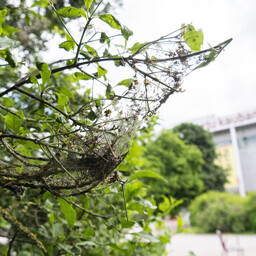Webworm moths are small butterflies. They create web nests on trees and shrubs. Their larvae live there. Sometimes an entire tree is covered with webs.
There are different species of webworm moths in Estonia. For example, the bird-cherry ermine moth and the willow ermine moth. Each species feeds on different trees or shrubs.
Webworm moths are small, white butterflies with black spots. They are up to 15 mm long. Their activity is visible on trees as gray webs.
Webworm moths live for one year. They fly in summer and lay eggs on trees. In autumn, the larvae hatch and overwinter. In spring, they feed on young leaves.
Sometimes there are many webworm moths. Then they can defoliate trees. But trees usually grow back.
Webworm moths have been known in Estonia for a long time. In 1749, the Senate ordered their destruction. Today, they are not a major threat. Trees recover quickly.
If there are too many webworm moths, they can be controlled. For example, apple trees are sprayed. Individual nests can also be removed manually.
Mostly, city dwellers don't need to worry about webworm moths. Trees and shrubs recover on their own. By the end of summer, the webs are often already gone.

